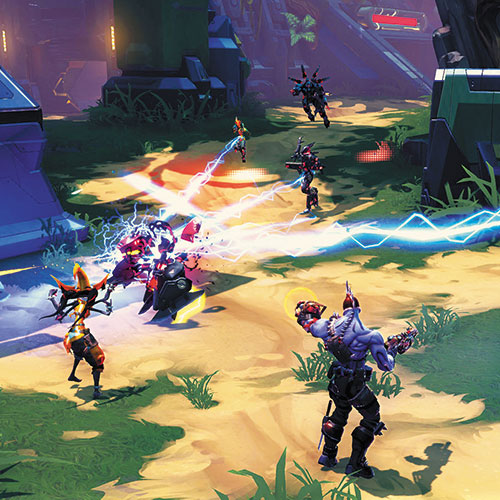Burning Out on ‘Battleborn”

By Steve Watts | Shacknews.com
Battleborn
Platforms: Microsoft Windows, PlayStation 4, Xbox One
Genre: First-person shooter
Developer: Gearbox Software
ESRB rating: T, for Teen
“Borderlands” may have established a signature Gearbox style, but “Battleborn” cements it. The visual style, humor and even branching upgrade paths owe so much to the studio’s popular series that I wouldn’t be surprised to learn this was an alternate multiplayer mode that spun off into its own series. In its best moments it’s a rollicking team-based adventure, but the singular focus can also make it feel repetitive.
BATTLING IT OUT
The story missions essentially fall into one of two types: tower defense style missions complete with buildable structures, and escort missions in which the defense point moves along with you. Shooters almost always carry the tendency toward repetition, but it’s especially pronounced here. Frankly you can only fight off waves of enemies so many times before you see the framework a little too clearly.
Its multiplayer modes are just as uneven, mostly due to the way it surrounds its best mode with two entirely unnecessary ones. Capture and Meltdown are control point and escort missions, respectively. They aren’t particularly inspired, and they don’t work very well within the framework of a multiplayer online battle arena-like progression system, so they come off as extra bits of fluff. I have to imagine Gearbox blanched at the idea of including a single multiplayer mode, but why not? Incursion, the most clearly MOBA-inspired one, is so head-and-shoulders above the other two that there’s really no reason to play them. The studio would have been better served by coming up with more maps and slight twists on Incursion than including what feel like space-fillers.
If you’ve ever even heard about a MOBA like “Dota 2” or “League of Legends,” you’ll understand Incursion instantly. Each team stands at opposite sides of the map, with narrow lanes between them, and the two clash at various points in the middle and attempt to destroy each other’s structure. The constant large group battle fits the traits and combat style of the characters much better than individual skirmishes scattered about the map, and the progression system allows a prolonged play session to constantly feel fresh by injecting new abilities throughout. It shouldn’t really come as a surprise that this MOBA-inspired game works best when it’s imitating a tried-and-true formula, but it does illustrate why the other two modes don’t work nearly as well. That leaves one genuinely fun, engaging multiplayer mode and two others.
CHARACTER ACTORS
What “Battleborn” lacks in gameplay variety, though, it makes up for with a massive roster of characters. This is another of the primary ways in which it takes notes from the ubiquitous MOBA genre. While the characters fall into a few simple arch-types like rogue or sniper, their individual abilities make each of them feel extremely differentiated. The game attempts to communicate this with a few keywords to describe each style, but there’s very little connective tissue in the categorization. Instead, it’s best to experience them for yourself. Unfortunately, many are roped off and require unlocking, either by playing multiple MP sessions or completing certain story missions.
Their individual abilities are the other standout MOBA-like. Rather than persistent upgrades a la “Borderlands,” each individual match has you choose from an upgrade path. Missions are structured to guide you all the way through the levels of upgrades if you make it to the end, and so eventually you’re meant to learn your build. A quick tap of two buttons can select your next upgrade, and you’ll be doing that frequently throughout a match. Some level of persistence is achieved through mutations — rewards for reaching character levels — which grant powered up versions of the existing upgrade tree.
When all of this works together, the game sings. It’s enormously fun to cut or shoot your way through swaths of enemies alongside your comrades. However, in single-player, the game appears to actively punish you for playing with other humans, because the difficulty scaling in the single-player missions is wildly skewed. I had a much easier time completing missions single-handedly than in a team, and felt discouraged from playing public games as a result. At first I chalked it up to general incompetence or lack of teamwork, but even when a team was working together well, the final waves of each stage are insanely overcrowded with enemies. And since these are standalone missions, losing at the last minute can mean an hour of wasted progress with no story progression to show for it. It should be the easiest and quickest way to unlock characters, but you’re better off playing multiplayer sessions instead.
Not to mention, you wouldn’t be missing much by circumventing the story. It’s silly and disconnected, and even the game’s own default of letting you tackle them in any order accents that we’re not meant to take it too seriously. The individual parts are delivered with a deft humorous touch, but it doesn’t really amount to much on the whole.
BATTLE BURNOUT
All of that makes “Battleborn” feel light, airy, and inconsequential. It’s enjoyable in its best moments and especially in one of its multiplayer modes, but the problem comes with its lack of longevity. It’s clearly a game built to be enjoyed in the long-term, like the MOBAs that inspired it, but it doesn’t have the legs to run that far. This is a game built to be played repeatedly over the course of months, but I felt tired of it after a week.











